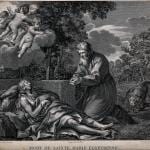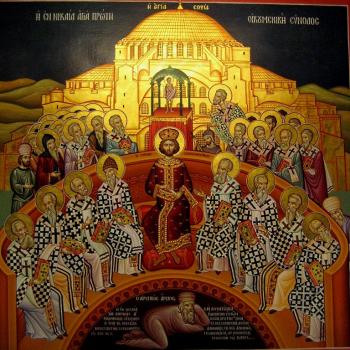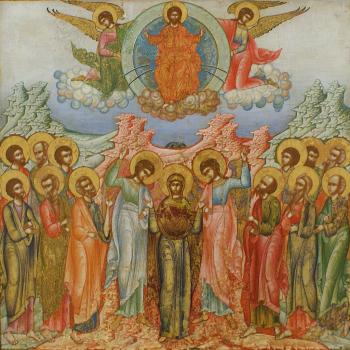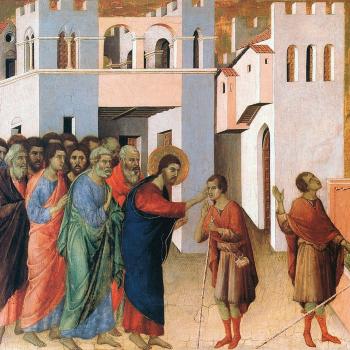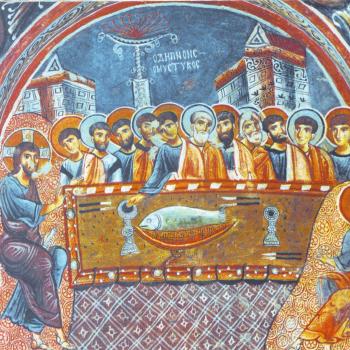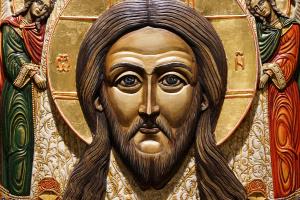
Eucharistic adoration is a treasured Western devotion to Christ. There is good with it, because the faithful go to Christ and adore him. It is always good to adore Christ, because, as God, he is not only love, but the source and foundation of all love. But, despite how popular a devotion it is now, eucharistic adoration is a rather recent innovation. As Móses Nóda writes, “In earliest Christianity, there was no Eucharistic worship outside the celebration. At an early stage, the Eucharist was reserved as a viaticum and for the communion of the sick.”[1] Traditionally, the eucharist was understood as having one fundamental purpose: giving us Christ as food:
Now, this sacrament is placed by the holy fathers in the genus of food and drink, and Christ himself also says [Jn 6.55-56], “For my flesh is true food, and my blood is true drink. He who eats my flesh and drinks my blood remains in me, and I in him.”[2]
The reality of the eucharist presence was affirmed, and in the middle of liturgical celebrations, adored, but such adoration was understood as being connected with and fulfilled in communion. This continues to be the normative understanding of the East, as Sergius Bulgakov explains:
Likewise, in the Eucharist, we have the appearance of Christ on earth – but also an appearance that is limited to the purpose of communion. We venerate the elements in the sacrament of communion, for in them Christ is present, offering Himself to the communicants. But we cannot “touch” Christ in them, and we do not seek to retain Him in our communion. [3]
The eucharistic presence is not a physical presence; the physical form is of bread and wine. When we eat and drink the bread and wine, except for particular eucharistic miracles, our senses experience the physical sensation of bread and wine. Our body experiences the eucharist as bread and wine (which is why those with celiac disease often cannot partake of the eucharistic bread). This is not to say it is not Christ. It really is Christ, but we have Christ, not in a physical form, but in a special sacramental presence.
The eucharist really is Jesus. We worship and adore him in and through the eucharistic presence, but we must remember the eucharist was established for us so that we can commune with Christ. Through such communion, we receive all kinds of graces: “It is clear that it causes communion in the fount of all grace, since in it we have communion with Christ so that he is in us and we in him, and it pours all that is his into us.” [4] And when we cannot receive the eucharist, we still are capable of receiving graces in spiritual communion, for God, in his love, will not deprive us of his love if we so desire it.
The desire to adore Christ is proper and just, but we must remember, it is not only done in and through eucharistic adoration. Indeed, long before eucharistic adoration was practiced, it had given to Christ through images (icons and statues). Adoration can, and often is, done in that fashion today. Those who want to adore Christ but find themselves unable to go to eucharistic adoration can and should consider adoring him through his image. Indeed, it is more natural to adore Christ through his image than it is through the eucharist, because the eucharistic presence does not offer the sensual impact of images to help direct us to think of Christ in personal terms which allow for such adoration.
The eucharist and images of Christ each provide us access to Christ’s presence, but as Sergius Bulgakov teaches, in differing ways:
From the fact that the icon and the Holy Gifts are both equally modes of Christ’s appearance, so to speak, it does not by any means follow that these two modes are identical. In the Holy Gifts the Lord is present essentially and really (praesentia realis), though He is present apart from His image, mysteriously. [5]
He is present in communion as food for the soul, while he is present in images in a form which we can comprehend, in a form which we can appeal to and interact with on a personal level. Images of Jesus allow us to engage him and respond to him as a person. This is why Bulgakov suggests we cannot and do not pray in the same way to Christ in the eucharistic presence as we do with images:
Of course, in the capacity of places of the appearance of Christ, both icons and the Holy Gifts are worthy of veneration (which is why we pray before the Holy Gifts at the liturgy). But this does not abolish the essential difference between them. And one can say (and this is something Roman Catholics do not feel) that one cannot pray to the Holy Gifts in the same way that one prays to an icon. In praying before an icon and contemplating the image, we are ascending in our thought to the Lord Himself, whereas in praying to the Holy Gifts we have before us the Lord Himself as if we no longer require the ascent in our thought toward Him though His image is not present before us. He gives Himself as heavenly food, heavenly bread for partaking and inner union with Him. Therefore, veneration of the Holy Gifts is both greater and less than the veneration of icons, and in general cannot be equated with the latter. [6]
Eucharistic adoration is far greater in the sense that we have the reality of Christ, and not just an image of Christ, but it is less in the sense that it is depersonalized while icons allow us to have a more personal connection with Christ. With the eucharist, we see and experience Christ in the accidents of bread and wine; it is a mysterious presence which elevates us and takes us into communion with Christ, but we still are confounded by the material form. The eucharist, being Christ, worthily receives our adoration when we give it, but we must remember that it is disconnected from the image of Christ. We must not think of the eucharist as an image which helps us focus our personal thoughts and feelings to Christ. It is, as St. Theodore the Studite indicates, the truth of Christ, not just an image:
What have you to say about these things that are reverently pronounced (hierologēthenta) and sung by the priests? Do you call them images, or truth? If you call them image, what nonsense! You go from blasphemy to blasphemy, like people who step into some sort of mud and fall down with both feet into something even more slippery as they try to go further. Indeed, you did not hesitate to incur the label of atheism to make sure your claims would be strengthened; and instead you call them truth – which indeed they are; indeed, the very body and blood of Christ are acknowledged in the reception on the part of the faithful, according to the words of divine origin – why then do you talk nonsense taking as types (typoi) the sacraments (mystēria) of truth? [7]
Bulgakov explains the meaning of this by telling us we must not try to turn the eucharist into an icon and try to worship and adore Christ in the eucharist the same way we do with icons. “The Orthodox (Theodore of Studios et. al.) argued that the elements are not an icon, because the Lord Himself in His body and blood is present in them.”[8]
But it can be asked, if an image of Christ is not the reality of Christ as we find in his presence, how can we adore Christ through images, which is exactly what we want to do and can do when we have the sacramental presence of Christ. The answer lies in the way images direct us to what is imagined in them:
An image is therefore a likeness and pattern and impression of something, showing itself what is depicted; however, the image is certainly not like the archetype, that is, what is depicted, in every respect – for the image is one thing and what it depicts is another – and certainly a difference is seen between them, since they are not identical. [9]
Images of Christ direct us to Christ so that we can give adoration to Christ through them. We are not giving such worship to the material form, but to what is imagined in them:
The image of Christ is nothing else but Christ, with the exception obviously of the substance, as has been indicated many times. Thus, it is the case that the veneration of the image is the same as the veneration of Christ; of course, the material of the image is not venerated, but rather only Christ who is expressed in the likeness in the image. [10]
And so, when we worship Christ through images, we are worshiping Christ, not the image. And as Christ is God, we can and should adore him and so we can and do give him adoration through the use of images, as St Thomas Aquinas also indicates:
I answer that, As the Philosopher says (De Memor. et Remin. i), there is a twofold movement of the mind towards an image: one indeed towards the image itself as a certain thing; another, towards the image in so far as it is the image of something else. And between these movements there is this difference; that the former, by which one is moved towards an image as a certain thing, is different from the movement towards the thing: whereas the latter movement, which is towards the image as an image, is one and the same as that which is towards the thing. Thus therefore we must say that no reverence is shown to Christ’s image, as a thing—for instance, carved or painted wood: because reverence is not due save to a rational creature. It follow therefore that reverence should be shown to it, in so far only as it is an image. Consequently the same reverence should be shown to Christ’s image as to Christ Himself. Since, therefore, Christ is adored with the adoration of “latria,” it follows that His image should be adored with the adoration of “latria.”[11]
We have access to Christ through his image. We can adore him through his image. When we want to adore Christ, we can be directed to him through his image. Christ relates to us through his image. We relate to him through his image. We understand him and find himself revealing himself to us through his image. When we want to show him our love, we can go to his image and find our spirit inspired by it so as to render our adoration to him. It is the same adoration which is given to him in the eucharist, but in a form which is established for that worship (while the eucharist is primarily established as spiritual food). Thus, while many are sad that they cannot go to a chapel and adore Christ in his eucharistic presence (because of being quarantined), they should not ignore the fact they still have access to Christ in his image and can adore him in and through it. Christ has not abandoned them, and so they do not need to abandon him.
[1] Móses Nóda, “Eucharistic Devotion. Historical and Theological Perspectives,” in Theologia Catholica Latina 1(2014): 49. While the practice begun in the late medieval era, in the 13th and 14th centuries, it was not as commonly practiced until after the Council of Trent.
[2] St. Albert the Great, On the Body of the Lord. Trans. Sr. Albert Marie Surmanski, OP (Washington, DC: CUA Press, 2017), 92.
[3] Sergius Bulgakov, “The Eucharistic Dogma” in The Holy Grail & The Eucharist. Trans. Boris Jakim (Hudson, NY: Lindisfarne Books, 1997), 122.
[4] St. Albert the Great, On the Body of the Lord, 263.
[5] Sergius Bulgakov, “The Icon and its Veneration” in Icons and the Name of God. Trans. Boris Jakim (Grand Rapids, MI: William B Eerdmans Publishing Company, 2012), 86.
[6] Sergius Bulgakov, “The Icon and its Veneration,” 87.
[7] St. Theodore the Studite, “First Refutation of the Iconoclasts” in Theodore the Studite: Writings on Iconoclasm. Trans. Thomas Cattoi (New York: The Newman Press, 2015), 53.
[8] Sergius Bulgakov, “The Eucharistic Dogma,” 123.
[9] St. John of Damascus, “Treatise 3” in On the Divine Images. Trans. Andrew Louth (Crestwood, NY: St. Vladimir’s Seminary Press, 2003), 95.
[10] St. Theodore the Studite, “Third Refutation of the Iconoclasts” in Theodore the Studite: Writings on Iconoclasm. Trans. Thomas Cattoi (New York: The Newman Press, 2015), 113.
[11] St. Thomas Aquinas, Summa Theologica. trans. Fathers of the English Dominican Province (New York: Benziger Brothers, 1948), III-25.3.
Stay in touch! Like A Little Bit of Nothing on Facebook.
If you liked what you read, please consider sharing it with your friends and family!


